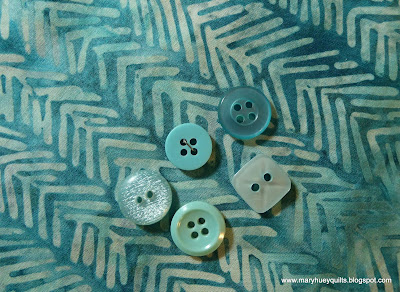My motivation for some May sewing this week is #memademay2017 on Instagram! I stumbled onto it last year and enjoyed seeing all the great clothing makes stitchers were sharing. There was lots of inspiration and I discovered some indie clothing pattern designers, so why not join in this year?
I prefer simple blouses to t-shirts and at the end of last summer, my favorite one wore out.
The neckband was frayed and the fabric was so thin, a hole just popped through in the back.
I found this old pattern in my stash -- same neckline, same sleeve style!
(I did a quick internet search and the company still has a
website HERE, but didn't find anyone selling their patterns.)
With cooler weather at hand, there was no rush so I watched for fabric I liked during the winter and took everything along to a retreat to cut out. There wasn't enough fabric for a collar for the first fabric I cut but one of the things I admire about young sewists these days is their comfort with "hacking" a pattern to meet their personal design ideas.
So I eliminated the collar on both blouses.
I needed to create my own back facing piece but that is in my skill set (have a degree in Clothing and Design which I rarely use these days, but it's good to have the skills when I need them!)
After tracing the neckline of the back pattern piece, I measured the depth of the front facing
making a series of dots that could be connected for the lower edge of the facing.
I labeled it and added it to my pattern pieces.
The pattern didn't call for interfacing in the neckline and front facings but I added it anyway to make the edges more durable.
Don't ever hesitate to take steps you know will improve the finished product.
I don't use my serger very much but I love having the ability to clean finish all my seams and hems -- so much more professional looking and less effort than zigzagging all over the garment.
And I can even "chain-piece"!!
I remember how much I hated setting sleeves in when I was a teenager learning garment construction.
It's really not that awful, just requires patience and careful attention. I do think the current strategy of setting a sleeve into a garment before the underarm seam is stitched makes the process easier.
It's one of the few times that I pin when I'm stitching and definitely worth the extra time it takes.
My assortment of buttons lives in color coordinated jars and since I tend to use them more for decorative purposes than clothing, it's sometimes a challenge to find enough for a garment.
Sorting through them on the fabric makes the decision easier.
Five pretty ones for the Liberty lawn fabric!
But there weren't five of any button in the "teal" jar. I've done mismatched buttons for decorative purposes before and picked out these five to use for the teal batik.
Love my Bernina presser feet when it comes to tasks like buttonholes.
This is the foot for the older mechanical machines -- matching the button to the red tab on the right and then sliding the red unit on the left along until the beginning of it is parallel to the opposite edge of the button always gives me the right length.
I also thread the bobbin thread through this little hole on the bobbin case finger to increase the bobbin thread tension. This "unbalancing" creates a smoother edge on the top side. It used to be a Bernina exclusive for machine with oscillating hooks.
It's also a good strategy when doing satin stitch machine work.
I was taught to always do a test buttonhole!!
"Painting" the back of the buttonhole with a seam sealant such as FrayCheck makes the buttonhole more durable. Just let it dry for 15 minutes before cutting it open.
This is a buttonhole cutter -- best investment ever. Clover makes them and they should come with a chuck of very hard wood to put underneath so you don't damage the table. Just press down and it punches the hole open. Less risky than sliding a ripper along and inadvertently cutting through the end of the stitching --- grrrrrr.
And here they are -- on their way to the closet!
The color of the Liberty lawn is more accurate in the pictures with the buttons but it's really dreary here today.
The backs -- the Liberty version has the yoke and the pleated back as the pattern was designed but I did a "hack" for the batik -- eliminating the yoke and the pleat.
Now I can get back to my piecing!! With the tunics I made this winter and these new blouses, my summer wardrobe is spruced up!
If you are on Instagram, check out that hashtag --
#memademay2017
-- and prepare to be impressed with all the garment construction that is going on out there!!
It might inspire you to break out your garment construction skills!
Hoping for a dry weekend!!
Mary






















































